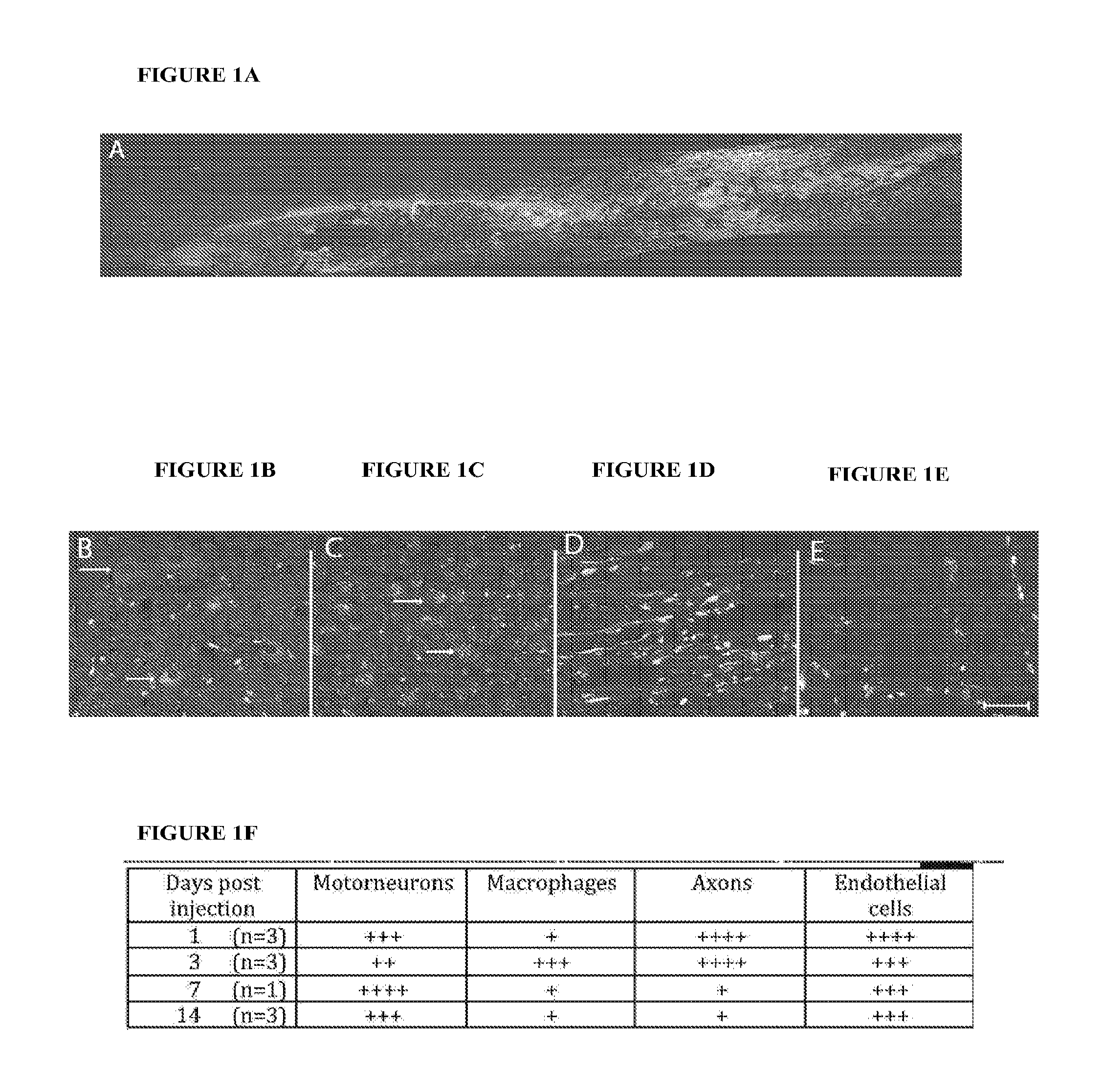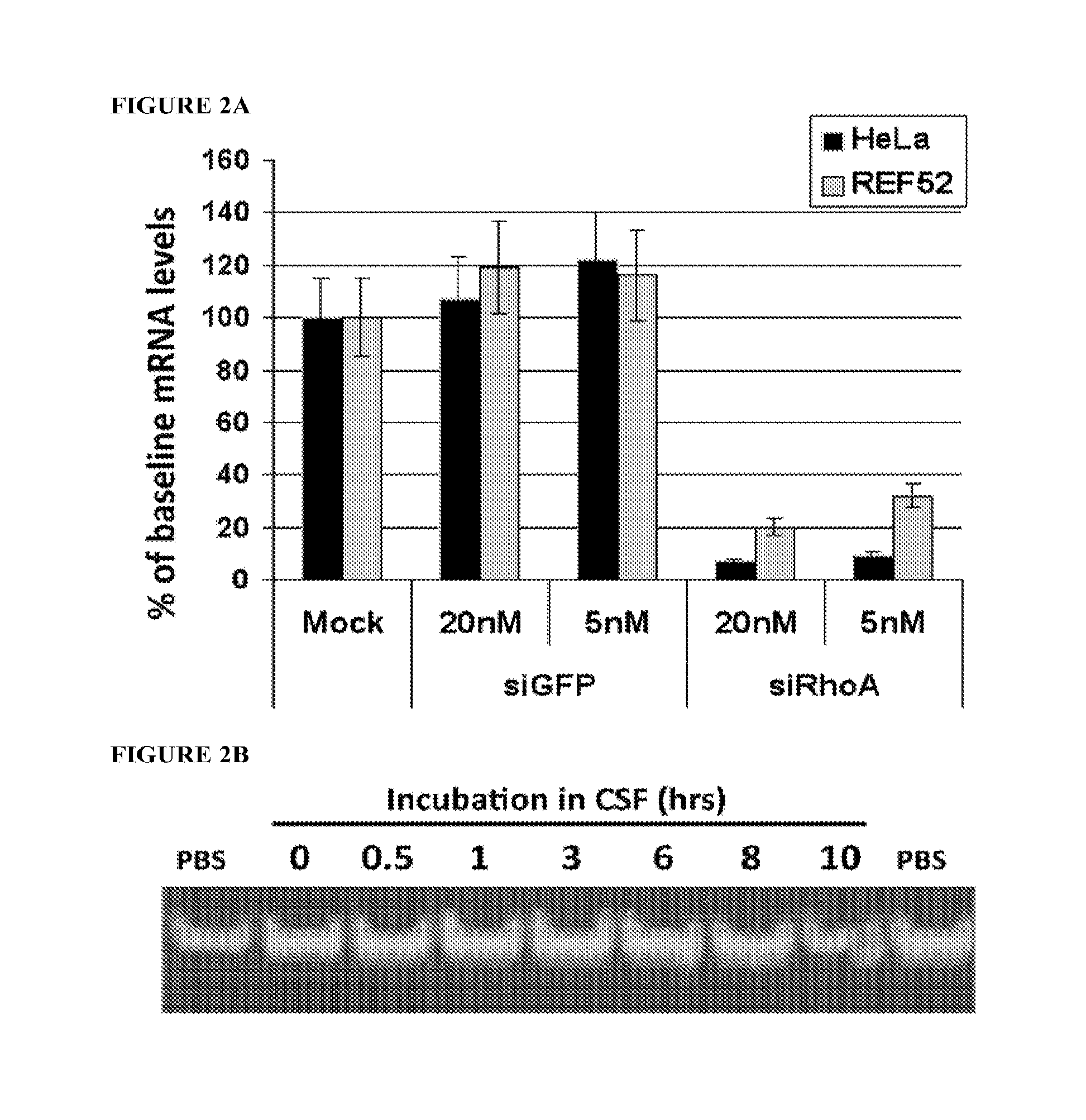Methods for delivery of sirna to the spinal cord and therapies arising therefrom
- Summary
- Abstract
- Description
- Claims
- Application Information
AI Technical Summary
Benefits of technology
Problems solved by technology
Method used
Image
Examples
example 1
Cellular Localization of siRNAs in Rat Spinal Cord following Spinal Cord Injury and Intraparenchymal Delivery
[0194]To develop siRNA therapies in spinal cord injury (SCI), the cells which incorporated labeled siRNA were identified. siRNAs conjugated with Cy3 as well as a specific sequence conjugated with Cy3.5 (REDD14 / Cy3.5) demonstrated incorporation into similar cell populations including motorneurons, macrophages, white matter axons, as well as neurons in the dorsal root and endothelial cells as shown in FIGS. 1A-1F. Thus, the siRNA is taken up by many of the cells where RhoA action has been implicated in SCI including neurons, astrocytes, microglia / macrophages and endothelial cells (D'Alessandri et al., 1995; Dubreuil et al., 2003. J Cell Biol 162(2): 233-43; Erschbamer et al., 2005. J Comp Neurol 484(2): 224-33; Yune et al., 2007. J Neurosci. 2007 Jul. 18;27(29):7751-61; Fu et al., 2007; Pixley et al., 2005. J Cell Sci. 2005 May 1;118(Pt 9):1873-83.; Schreibelt et al., 2007. FAS...
example 2
Further Experimental Results Demonstrating that siRNA Inhibition of RhoA Promotes Functional Recovery from SCI and Prevents Allodynia
[0204]Material and Methods
[0205]Animals and spinal cord injury: The experiments were performed using 125 Sprague-Dawley female rats (10-11 weeks old) (Taconic, Germantown, N.Y.). For SCI surgery, rats were anesthetized with 2% isoflurane (IsoFlo, Abbott Lab, North Chicago, Ill.) and the spinal cord was exposed by laminectomy at T9-10 and then contused by dropping a 10.0 g rod on the exposed T11 cord from a height of 12.5 or 25 mm, as described (Constantini and Young, 1994; Hasegawa et al., 2005). Following the contusion and injections when performed, muscles and skin were closed separately. Cefazolin (25 mg / kg) was administered to all rats.
[0206]siRNA injection: Injections at the injury site were performed within 30 minutes prior to injury; 1 μg in 1 μl of siRNA was injected at each of three points including the injury epicenter, and 2 mm rostral and c...
example 3
siRhoA and siTLR4 can Prevent and Treat Allodynia
[0227]Therapeutic activity of siRNA directed to RhoA mRNA (SEQ ID NO:1) or TLR4 mRNA (SEQ ID NO:2) in the Spinal Nerve Ligation Model (Chung) in rats
[0228]The Chung (Kim and Chung, 1992. Pain. 1992 September;50(3):355-63.) rat model duplicates the symptoms of human patients with causalgia, or burning pain due to injury of a peripheral nerve. The Chung procedure produces a long-lasting hyperalgesia to noxious heat and mechanical allodynia of the affected foot. Rats with spinal nerve ligation (SNL) are useful for identifying active dsRNA compounds for use in alleviating neuropathic pain.
[0229]Alleviation Of Neuropathic Pain in Chung Model Rats
[0230]The surgical procedure previously described by Kim and Chung, 1992, was performed on male Sprague-Dawley rats weighing 190 to 2100 grams to induce an allodynic state. Animals were acclimated for at least 5 days. During acclimation and throughout the entire study duration, animals were housed ...
PUM
| Property | Measurement | Unit |
|---|---|---|
| Time | aaaaa | aaaaa |
| Time | aaaaa | aaaaa |
| Volume | aaaaa | aaaaa |
Abstract
Description
Claims
Application Information
 Login to View More
Login to View More - R&D
- Intellectual Property
- Life Sciences
- Materials
- Tech Scout
- Unparalleled Data Quality
- Higher Quality Content
- 60% Fewer Hallucinations
Browse by: Latest US Patents, China's latest patents, Technical Efficacy Thesaurus, Application Domain, Technology Topic, Popular Technical Reports.
© 2025 PatSnap. All rights reserved.Legal|Privacy policy|Modern Slavery Act Transparency Statement|Sitemap|About US| Contact US: help@patsnap.com



